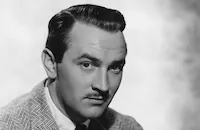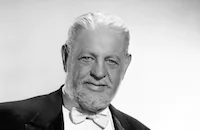Design for Scandal

Brief Synopsis
Cast & Crew
Norman Taurog
Rosalind Russell
Walter Pidgeon
Edward Arnold
Lee Bowman
Jean Rogers
Film Details
Technical Specs

Synopsis
Newspaper tycoon Judson M. Blair has had enough of his wife Adele's extravagances, so when the former chorine refuses to return an expensive ring she has just bought, he sues for divorce. Unfortunately for Blair, the hearing judge, Cornelia Porter, refuses to listen to his remarks about Adele and grants her alimony of $4,000 a month, unless she remarries. Because Cornelia will not even consider changing her mind, Blair decides that the only way he can better his situation is if a scandal causes the upstanding judge to leave the bench. Ace reporter Jeff Sherman, whom Blair has repeatedly fired, offers to help out, but only if Blair will rehire him, raise his salary and move him to the Washington beat. Jeff then goes to his manicurist friend Dotty, and offers her money to take out a marriage license with him, then sue Cornelia for alienation of affection after Jeff has had a chance to romance her. Jeff soon follows Cornelia to Cape Cod, where she plans to spend a two-month vacation with her sister Jane and nephew Freddie, and do some amateur sculpting. Jeff's plans to meet Cornelia on the train go awry when Freddie will not cooperate, so on Cape Cod, Jeff manages to take over the studio of Raoul, a local sculptor, by having Blair hire him away to work on his New York office building. Several attempts to get close to Cornelia fail, until Jeff is invited to dinner by Jane after he pretends to save Freddie from drowning. Cornelia is suspicious of Jeff, as is her longtime suitor, Walter Caldwell, but when she sees "his" sculptures, and they have fun singing together on a moonlight tandem bicycle ride, she changes her opinion. After spending more time together, Jeff invites Cornelia to his studio, but while she is there, Dotty calls to say that she is in town. Jeff makes an excuse to Cornelia, then gets Dotty drunk and promises to marry her if she will go back to New York and return the next Saturday. While Jeff starts to fall in love with Cornelia, Dotty is on a spending spree in New York and confronts Blair about giving her more money. When Saturday arrives, Jeff decides that he cannot go through with his plan and returns to New York to tell Blair. While he is gone, Cornelia goes to the studio and finds Raoul, who unwittingly reveals that Jeff is working for Blair. In New York, just as Jeff is telling Blair that Cornelia is too fine a lady to be tricked, they are both arrested. In court, Cornelia acts as the prosecuting attorney, while her friend and mentor, Judge Graham, presides. Jeff acts as his own attorney and when he presents his case, he calls Cornelia to the witness stand. Although she is hostile, he proposes and she eventually admits that she loves him, then rushes out of the courtroom in tears. Graham finds Jeff and Blair guilty but only sentences them to one day in jail. Outside the courthouse, after Jeff sees a newspaper headline announcing Adele's marriage to an old millionaire, he falls down because Blair had just given her a big settlement to stop the monthly alimony payments. Although he is not hurt, Cornelia thinks he is and rushes to him. Sometime later, Cornelia and Jeff are happily singing "Daisy Bell" on Cape Cod as they once again ride a bicycle built for two.

Director

Norman Taurog
Cast

Rosalind Russell

Walter Pidgeon

Edward Arnold

Lee Bowman

Jean Rogers
Mary Beth Hughes

Guy Kibbee
Barbara Jo Allen
Leon Belasco
Bobby Larson
Charles Coleman

Thurston Hall

Anne Revere
George Chandler
George Watts

Addison Richards
Crew
John W. Considine Jr.
Harry Dacre
Cedric Gibbons
Sydney Guilaroff
Lionel Houser
Kalloch
Harry Mcafee
Douglas Shearer
Leonard Smith
Elmo Veron
Franz Waxman
Edwin B. Willis
Dolph Zimmer

Photo Collections
Film Details
Technical Specs

Articles
Design for Scandal
Russell had been one of the last MGM stars signed and groomed by Irving Thalberg, but initially she was treated as a second-lead version of Myrna Loy. She made it into major roles in drama at first, with hits in 1937's Night Must Fall, with Robert Montgomery, and 1938's The Citadel, with Robert Donat. Then in 1939 she fought for the role of an acid-tongued society gossip in The Women and pretty much stole the picture from an all-star cast that included Norma Shearer, Joan Crawford, Paulette Goddard and Joan Fontaine. The film established her as one of Hollywood's top comediennes and fastest-talking actresses. The following year, Columbia borrowed her to play the tough news hen working for unscrupulous editor Cary Grant in the screen's greatest newspaper comedy, His Girl Friday, and Russell's future as a career woman was set. Design for Scandal continued that typing, followed by such comic hits as My Sister Eileen, which brought Russell her first Oscar nomination, and Take a Letter, Darling, both in 1942.
His Girl Friday played another important role in Russell's life when co-star Grant introduced her to producer Carl Brisson. They married in 1941, shortly after she had finished work on Design for Scandal, and he would play a major role in shaping her career. Just for starters, he convinced her not to re-sign with MGM when her initial seven-year contract expired.
Russell was always lucky in her leading men. Grant had helped re-shape her career, and she had scored comic triumphs opposite James Stewart (No Time for Comedy, 1940) and Melvyn Douglas (This Thing Called Love, 1941). She was just as lucky in Design for Scandal, in which she co-starred with the often under-rated Walter Pidgeon. Pidgeon was MGM's all-purpose leading man of the forties, particularly as Greer Garson's teammate in eight films, including the Oscar-winning Mrs. Miniver. But though he rarely got a chance to shine on his own (as he did on loan to 20th Century-Fox for Fritz Lang's 1942 Man Hunt), he had a unique talent for making the studio's female stars look smart and sexy, which is just what happened in Design for Scandal. With Pidgeon as her co-star, Russell looked like an asset the studio could ill afford to lose.
Producer: John W. Considine, Jr.
Director: Norman Taurog
Screenplay: Lionel Houser
Cinematography: Leonard Smith, William Daniels
Art Direction: Cedric Gibbons
Music: Franz Waxman
Cast: Rosalind Russell (Cornelia Porter), Walter Pidgeon (Jeff Sherman), Edward Arnold (Judson M. Blair), Vera Vague (Jane Porter), Lee Bowman (Walter Caldwell), Jean Rogers (Dotty), Donald Meek (Mr. Wade), Guy Kibbee (Judge Graham), Anne Revere (Nettie, the Maid).
by Frank Miller

Design for Scandal
Quotes
Trivia
Notes
Working titles of the film were Miss Achilles' Heel, Achilles and Her Honor. Actress Barbara Jo Allen is billed as "Barbara Jo Allen (Vera Vague)" in the opening credits, but only as Barbara Jo Allen in the end credits. "Vera Vague" was the name of the popular radio character she portrayed on Bob Hope's program The Pepsident Hour. Hollywood Reporter news items note that Sam Taylor was originally set to direct the picture, which was to star Clark Gable. Other news items noted that although actress Rosalind Russell was supposed to leave M-G-M after having bought out her contract, she agreed to stay on for this film, and that actor Charie Ruggles was wanted for a role in the film if he completed work on Columbia's Go West, Young Lady (see below). According to Hollywood Reporter production charts, Claire Trevor was in the cast, but she was not in the released film. According to Hollywood Reporter news items, some location shooting was done near Santa Monica, CA and at actor Jack Oakie's Venijay Ranch in Southern California.















